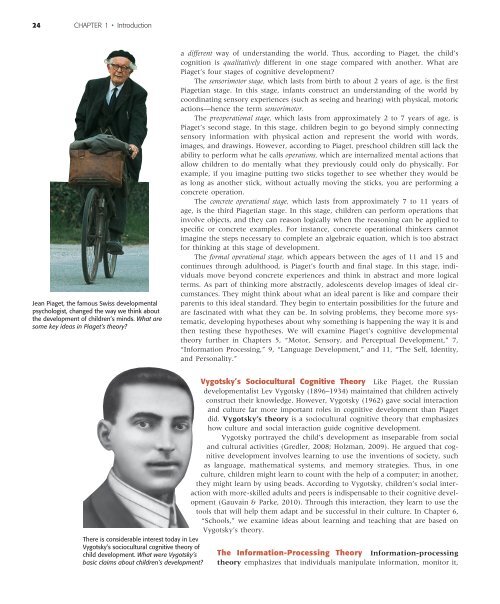Research in Life-Span Development
Research in Life-Span Development
Research in Life-Span Development
Create successful ePaper yourself
Turn your PDF publications into a flip-book with our unique Google optimized e-Paper software.
24 CHAPTER 1 Introduction<br />
Jean Piaget, the famous Swiss developmental<br />
psychologist, changed the way we th<strong>in</strong>k about<br />
the development of children’s m<strong>in</strong>ds. What are<br />
some key ideas <strong>in</strong> Piaget’s theory?<br />
There is considerable <strong>in</strong>terest today <strong>in</strong> Lev<br />
Vygotsky’s sociocultural cognitive theory of<br />
child development. What were Vygotsky’s<br />
basic claims about children’s development?<br />
a different way of understand<strong>in</strong>g the world. Thus, accord<strong>in</strong>g to Piaget, the child’s<br />
cognition is qualitatively different <strong>in</strong> one stage compared with another. What are<br />
Piaget’s four stages of cognitive development?<br />
The sensorimotor stage, which lasts from birth to about 2 years of age, is the fi rst<br />
Piagetian stage. In this stage, <strong>in</strong>fants construct an understand<strong>in</strong>g of the world by<br />
coord<strong>in</strong>at<strong>in</strong>g sensory experiences (such as see<strong>in</strong>g and hear<strong>in</strong>g) with physical, motoric<br />
actions—hence the term sensorimotor.<br />
The preoperational stage, which lasts from approximately 2 to 7 years of age, is<br />
Piaget’s second stage. In this stage, children beg<strong>in</strong> to go beyond simply connect<strong>in</strong>g<br />
sensory <strong>in</strong>formation with physical action and represent the world with words,<br />
images, and draw<strong>in</strong>gs. However, accord<strong>in</strong>g to Piaget, preschool children still lack the<br />
ability to perform what he calls operations, which are <strong>in</strong>ternalized mental actions that<br />
allow children to do mentally what they previously could only do physically. For<br />
example, if you imag<strong>in</strong>e putt<strong>in</strong>g two sticks together to see whether they would be<br />
as long as another stick, without actually mov<strong>in</strong>g the sticks, you are perform<strong>in</strong>g a<br />
concrete operation.<br />
The concrete operational stage, which lasts from approximately 7 to 11 years of<br />
age, is the third Piagetian stage. In this stage, children can perform operations that<br />
<strong>in</strong>volve objects, and they can reason logically when the reason<strong>in</strong>g can be applied to<br />
specifi c or concrete examples. For <strong>in</strong>stance, concrete operational th<strong>in</strong>kers cannot<br />
imag<strong>in</strong>e the steps necessary to complete an algebraic equation, which is too abstract<br />
for th<strong>in</strong>k<strong>in</strong>g at this stage of development.<br />
The formal operational stage, which appears between the ages of 11 and 15 and<br />
cont<strong>in</strong>ues through adulthood, is Piaget’s fourth and fi nal stage. In this stage, <strong>in</strong>dividuals<br />
move beyond concrete experiences and th<strong>in</strong>k <strong>in</strong> abstract and more logical<br />
terms. As part of th<strong>in</strong>k<strong>in</strong>g more abstractly, adolescents develop images of ideal circumstances.<br />
They might th<strong>in</strong>k about what an ideal parent is like and compare their<br />
parents to this ideal standard. They beg<strong>in</strong> to enterta<strong>in</strong> possibilities for the future and<br />
are fasc<strong>in</strong>ated with what they can be. In solv<strong>in</strong>g problems, they become more systematic,<br />
develop<strong>in</strong>g hypotheses about why someth<strong>in</strong>g is happen<strong>in</strong>g the way it is and<br />
then test<strong>in</strong>g these hypotheses. We will exam<strong>in</strong>e Piaget’s cognitive developmental<br />
theory further <strong>in</strong> Chapters 5, “Motor, Sensory, and Perceptual <strong>Development</strong>,” 7,<br />
“Information Process<strong>in</strong>g,” 9, “Language <strong>Development</strong>,” and 11, “The Self, Identity,<br />
and Personality.”<br />
Vygotsky’s Sociocultural Cognitive Theory Like Piaget, the Russian<br />
developmentalist Lev Vygotsky (1896–1934) ma<strong>in</strong>ta<strong>in</strong>ed that children actively<br />
construct their knowledge. However, Vygotsky (1962) gave social <strong>in</strong>teraction<br />
and culture far more important roles <strong>in</strong> cognitive development than Piaget<br />
did. Vygotsky’s theory is a sociocultural cognitive theory that emphasizes<br />
how culture and social <strong>in</strong>teraction guide cognitive development.<br />
Vygotsky portrayed the child’s development as <strong>in</strong>separable from social<br />
and cultural activities (Gredler, 2008; Holzman, 2009). He argued that cognitive<br />
development <strong>in</strong>volves learn<strong>in</strong>g to use the <strong>in</strong>ventions of society, such<br />
as language, mathematical systems, and memory strategies. Thus, <strong>in</strong> one<br />
culture, children might learn to count with the help of a computer; <strong>in</strong> another,<br />
they might learn by us<strong>in</strong>g beads. Accord<strong>in</strong>g to Vygotsky, children’s social <strong>in</strong>teraction<br />
with more-skilled adults and peers is <strong>in</strong>dispensable to their cognitive development<br />
(Gauva<strong>in</strong> & Parke, 2010). Through this <strong>in</strong>teraction, they learn to use the<br />
tools that will help them adapt and be successful <strong>in</strong> their culture. In Chapter 6,<br />
“Schools,” we exam<strong>in</strong>e ideas about learn<strong>in</strong>g and teach<strong>in</strong>g that are based on<br />
Vygotsky’s theory.<br />
The Information-Process<strong>in</strong>g Theory Information-process<strong>in</strong>g<br />
theory emphasizes that <strong>in</strong>dividuals manipulate <strong>in</strong>formation, monitor it,

















